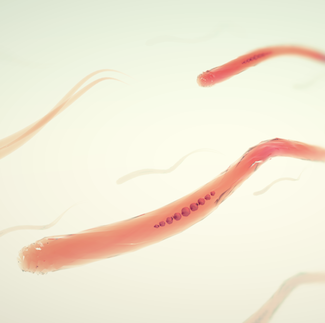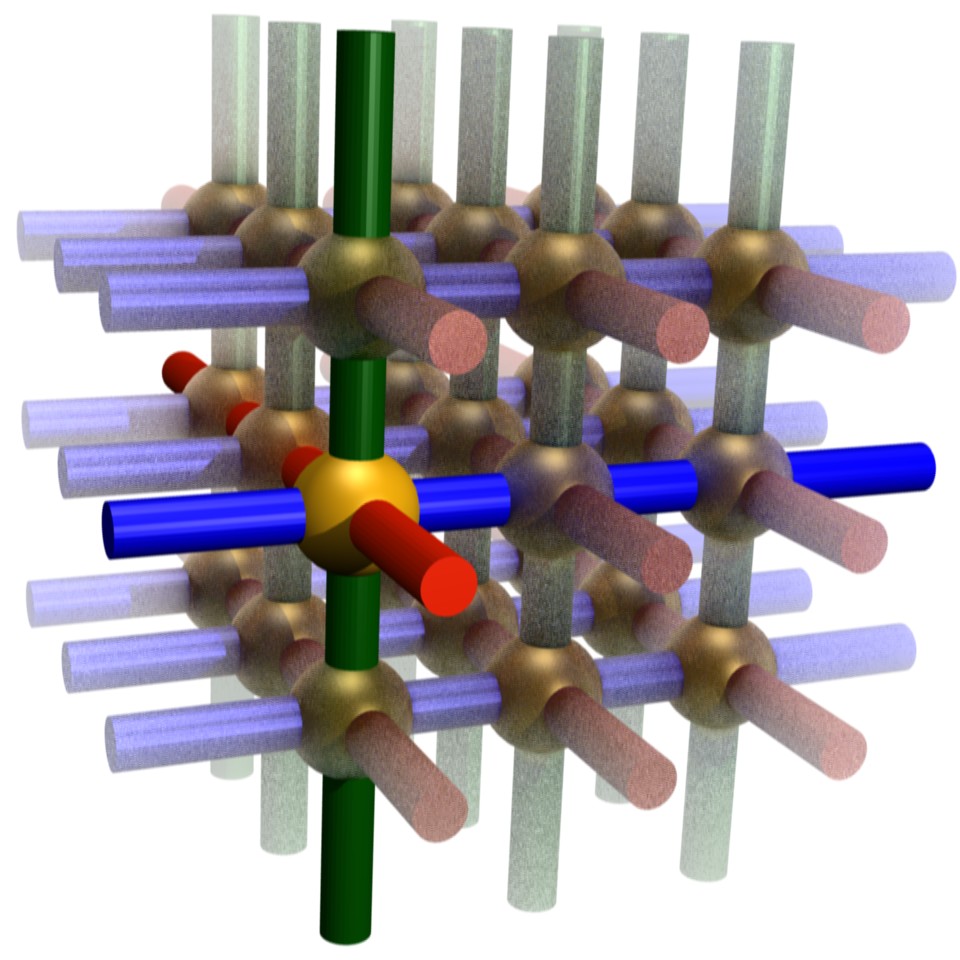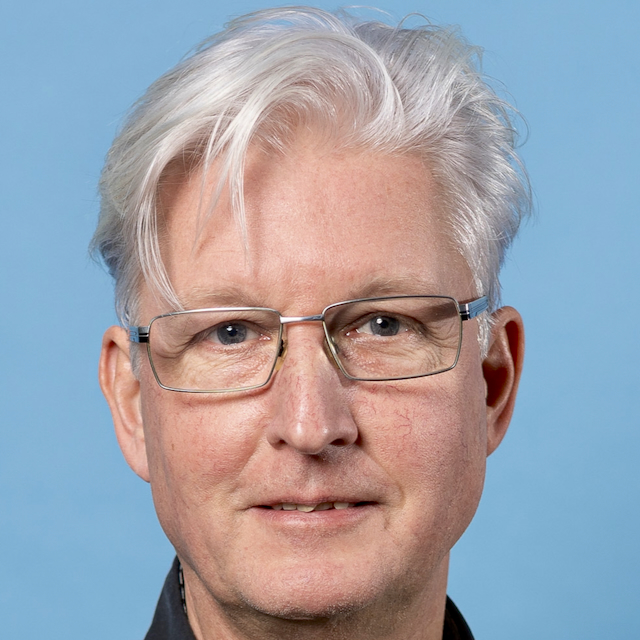Leon Abelmann (1965) received his MSc degree in Electrical Engineering at the University of Twente, The Netherlands, in 1990 with a specialization in the area of integrated optics. He spent the first two years of his Ph.D. study at CNRS in Meudon, France, studying oblique evaporation of thin magnetic films. He continued this research at the University of Twente, where he obtained his Ph.D. degree in 1994 with Professor Lodder and subsequently moved into the novel field of magnetic force microscopy.
In 1997 Leon Abelmann received a grant from the Royal Dutch Academy of Sciences, allowing him to spend one year as a postdoctoral researcher at the Data Storage Systems Center at Carnegie Mellon University, Pittsburg, USA in 1999, where he worked on micromagnetic simulations. In 2000 he received an Innovation Grant from the Netherlands Organisation for Scientific Research (NWO), which allowed him to work on probe-based data storage. He was appointed Assistant Professor in 2001, and Associate Professor and interim chairholder in 2004 after the retirement of Professor Lodder.
In 2006 Leon Abelmann and his team joined the Transducer Science and Technology group of Professor Elwenspoek, where he continued his work on novel, MEMS-based, information storage systems and nanomagnetism. In 2010 he extended his research towards self-assembly, focussing on magnetic forces to steer the assembly process and self-assembly of magnetically functionalized units, and was appointed full professor.
In 2013, Leon Abelmann started as principal scientist at the European branch of the Korean Institute of Science and Technology in Saarbrücken, where he moved his field towards nanotechnology and magnetism for life sciences. He maintained his professorship at the University of Twente to strengthen the connection with KIST Europe and Korea. In 2014, Leon Abelmann was appointed honorarprofessor at Saarland University, in the department of Mechatronics, to strengthen the academic cooperation between Korea and Saarland University.
In 2022, he returned to academia as an associate professor at the Electrical Engineering Department of the Delft University of Technology. Here he focuses on educational innovation, magnetism for biomedical applications, and self-assembly.
Leon Abelmann is (co)author of over 150 peer-reviewed publications. He was chairman of the steering committee of the MME workshop and chairman of the European School on Magnetism (Saarbrücken, 2022). Leon was very active in education in the Electrical Engineering and Advanced Technology programs, as well as the Honours Program of the University of Twente. He was nominated Teacher of the Year for Electrical Engineering from 2002 to 2011, only interrupted in 2010, and was a recipient of the prize in 2005. He received the best teacher award for the Advanced Technology bachelor program in 2010, and the award for excellent education by the TNW department in 2012.
- Details
- Written by: Leon - su
- Category: Uncategorised
- Hits: 277
PhD students with whom I am happy to work with today
- Johan Meyer - Magnetic neurostimulation
PhD students with whom I am proud to have been working with in the past
- Arnout van den Bos "Canticlever - Planar fabrication of probes for magnetic imaging"
- Mink Hoexum "Unleashed Microactuators electrostatic wireless actuation for probe-based data storage."
- Rogelio Murillo "Magnetic media patterned by laser interference lithography."
- Alexander Le Febre "Field emission sensing for non-contact probe recording."
- Johan Engelen "Optimization of Comb-Drive Actuators"
- Wabe Koelmans "Parallel Probe Readout."
- Hammad Nazeer "Thin Films on Cantilevers"
- Jeroen de Vries "Energy Barriers in Patterned Media"
- Bram Krijnen "A large-stroke planar MEMS-based stage with integrated feedback "
- Antoine Legrain "Elastocapillary self-folding of micro-machined structures"
- Laurens Alink "Magnetic Interaction in 2D and 3D arrays"
- Kodai Hatakeyama "Challenges of scanning hall microscopy using batch fabricated probes"
- Per Löthman "Macroscopic Magnetic Self-assembly"
- Marc Pichel "The behaviour of magnetotactic bacteria in changing magnetic fields"
- Tijmen Hageman "Observing magnetic objects in fluids"
- Details
- Written by: Leon - su
- Category: Uncategorised
- Hits: 328
University of Twente Research Information
Delft University of Technology Research Information
- Details
- Written by: Leon Abelmann
- Category: Uncategorised
- Hits: 475
We managed to grow a three-dimensional crystal using dipolar forces. Read more in our Science Advances publication.
News coverage:
- Details
- Written by: Leon - su
- Category: Uncategorised
- Hits: 327
My expertise lies in magnetostatics on the micro- and nanoscale. As a PhD student and postdoc, I worked mainly in the area of magnetic data storage, moving from tape recording to magnetic force microscopy, magnetic patterned media and probe storage. When the magnetic recording industry left Europe entirely, I changed my research field towards magnetostatics in combination with fluids. I currently address two main fields.
Magnetism in life sciences
 Magnetism combines well with organisms, since magnetic fields penetrate in most aqueous solutions and hardly interact with bio-chemical processes. Magnetic fields can for instance be used to apply forces and torques (using either magnetic particles or non-magnetic particles in magnetic fluids), to heat magnetic particles by induction or to detect their presence. My research team combines magnetic fields with microfluidic systems to study fundamental behavior of magnetic particles in solutions, or non-magnetic particles in magnetic solutions and to apply this in life sciences. Of special interest are magneto-tactic bacteria, which are self-propelling and can be controlled without having to apply large magnetic field gradients. We study manipulation of individual magneto-tactic bacteria inside micro-fluidic systems as model systems for future self-propelled medical micro-robots.
Magnetism combines well with organisms, since magnetic fields penetrate in most aqueous solutions and hardly interact with bio-chemical processes. Magnetic fields can for instance be used to apply forces and torques (using either magnetic particles or non-magnetic particles in magnetic fluids), to heat magnetic particles by induction or to detect their presence. My research team combines magnetic fields with microfluidic systems to study fundamental behavior of magnetic particles in solutions, or non-magnetic particles in magnetic solutions and to apply this in life sciences. Of special interest are magneto-tactic bacteria, which are self-propelling and can be controlled without having to apply large magnetic field gradients. We study manipulation of individual magneto-tactic bacteria inside micro-fluidic systems as model systems for future self-propelled medical micro-robots.
Magnetically assisted three-dimensional self-assembly
 As mind-blowing as the achievements of lithography based micro-fabrication may be, the techniques remain essentially two-dimensional. In MEMS, this severely limits our design capabilities, especially for out-of-plane structures. In micro-electronics and data storage we will hit a fundamental limit on miniaturisation when the size of bits or electric connections reaches atomic dimensions. The only way forward is towards the third dimension, and in my opinion three-dimensional self-assembly is the only viable option on the long term. In self-assembly, the properties of the individual particles determine the final structure of the assembly. In my team, we use magnetism to tailor the interacting forces between particles, using either magnetic particles or non-magnetic particles in magnetic fluids. We transfer fundamental knowledge obtained at the millimeter scale to the micro- and nano-domain, and are especially interested in particles with low symmetry.
As mind-blowing as the achievements of lithography based micro-fabrication may be, the techniques remain essentially two-dimensional. In MEMS, this severely limits our design capabilities, especially for out-of-plane structures. In micro-electronics and data storage we will hit a fundamental limit on miniaturisation when the size of bits or electric connections reaches atomic dimensions. The only way forward is towards the third dimension, and in my opinion three-dimensional self-assembly is the only viable option on the long term. In self-assembly, the properties of the individual particles determine the final structure of the assembly. In my team, we use magnetism to tailor the interacting forces between particles, using either magnetic particles or non-magnetic particles in magnetic fluids. We transfer fundamental knowledge obtained at the millimeter scale to the micro- and nano-domain, and are especially interested in particles with low symmetry.
- Details
- Written by: Leon - su
- Category: Uncategorised
- Hits: 328
